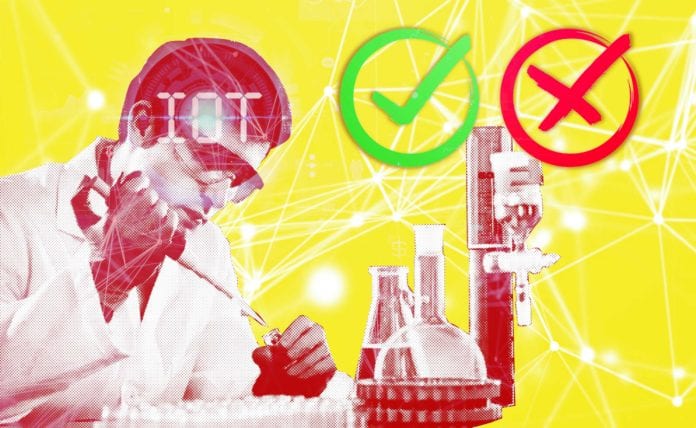
What can IoT do for healthcare? The applications are so diverse that you probably wouldn’t believe these examples are taken from real life. Here are just a few:
- Symptom-tracking apps that send updates on responses to treatment to the physician and which can avoid hospitalization
- Connected hospital equipment that notifies doctors of their current location, informs the hospital management of replacement needs, and monitors staff performance
- Remote temperature monitoring ensuring the correct transportation and storage of vaccines
- Healthcare IT solutions that remind patients to refill medication and digestible sensors that trigger a notification if the medication hasn’t been taken on time
- Continuous Glucose Monitors (CGM) and smart insulin pens that record and recommend the time and the amount of insulin dose injection which come to the rescue of diabetics
- Smart inhalers connected to an app that help people with asthma and pulmonary disease understand what causes the symptoms and predict allergens
Given these examples, IoT is seen as a way of living a smarter and safer life and its application is highly encouraged in medical establishments. However, digital transformation in healthcare isn’t without threats. It’s important to weigh all the advantages and disadvantages of implementing IoT systems in healthcare to be able to plan for ways to maximize the pros while mitigating the cons.
“It’s important to weigh all the advantages and disadvantages of implementing IoT systems in healthcare to be able to plan for ways to maximize the pros while mitigating the cons.”
-Yaryna Myrka
Major Advantages of IoT in Healthcare
The overall importance of healthcare software solutions is difficult to overestimate as technology promises to make healthcare services more effective and alleviate the burden placed on healthcare providers. This is critical in the context of the aging population and the increase in the number of chronic diseases.
The main advantages of IoT implementation in healthcare:
- Remote monitoring: Real-time remote monitoring via connected IoT devices and smart alerts can diagnose illnesses, treat diseases, and save lives in case of a medical emergency.
- Prevention: Smart sensors analyze health conditions, lifestyle choices, and the environment and recommend preventative measures, which will reduce the occurrence of diseases and acute states.
- Reduction of healthcare costs: IoT reduces costly visits to doctors and hospital admissions and makes testing more affordable.
- Medical data accessibility: Accessibility of electronic medical records allow patients to receive quality care and help healthcare providers make the right medical decisions and prevent complications.
- Improved treatment management: IoT devices help track the administration of drugs and the response to the treatment and reduce medical errors.
- Improved healthcare management: Using IoT devices, healthcare authorities can get valuable information about equipment and staff effectiveness and use it to suggest innovations.
- Research: Since IoT devices are can collect and analyze a massive amount of data, they have a high potential for medical research purposes.
IoT in Healthcare: Challenges and Threats
Although the Internet of Things can be of great benefit to healthcare, there are still major challenges to address before full-scale implementation. Some of the threats and disadvantages of using connected devices in healthcare are:
- Security and privacy: Security and privacy remain a major concern deterring users from using IoT technology for medical purposes, as healthcare monitoring solutions have the potential to be breached or hacked. The leak of sensitive information about the patient’s health and location and meddling with sensor data can have grave consequences, which would counter the benefits of IoT.
- Risk of failure: Failure or bugs in the hardware or even power failure can impact the performance of sensors and connected equipment placing healthcare operations at risk. In addition, skipping a scheduled software update may be even more hazardous than skipping a doctor’s checkup.
- Integration: There’s no consensus regarding IoT protocols and standards, so devices produced by different manufacturers may not work well together. The lack of uniformity prevents full-scale integration of IoT, therefore limiting its potential effectiveness.
- Cost: While IoT promises to reduce the cost of healthcare in the long term, the cost of its implementation in hospitals and staff training is quite high.
The Future of IoT in Healthcare
According to a Straits Research report, the market for IoT healthcare technology will rise to $486 billion by 2031. Such growth will be due to the increasing demand, the improvement of 5G connectivity and IoT technology, and the growing acceptance of healthcare IT software. The plans of tech giants like Apple, Google, and Samsung to invest in bridging the gap between fitness-tracking apps and actual medical care are sure to contribute to the process too.
Despite the downsides, further digital transformation in healthcare is inevitable and the concept of IoT will continue to capture and change the landscape of healthcare services. Thus, it seems to be high time to look beyond the challenges and embark on the journey to connected healthcare devices.
Originally published on March 17, 2020. Updated January 17, 2022.
Tweet
Share
Share
- Health and Wellness
- Healthcare
- Internet of Things
- Health and Wellness
- Healthcare
- Internet of Things
